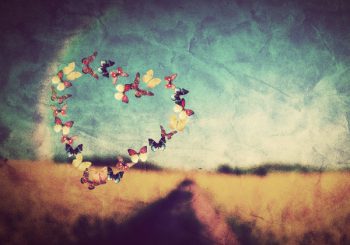Contributing writer for Wake Up World
The more we try to manually let go of heartache, the more we get in the way of healing.
In my experience through grief work and the trenches of heartbreak, I have noticed that I don’t let go of pain as much as pain lets us go of me. I “achieve” this via grieving, which is our psyche’s innate response to loss. This is the very experience of transformation via entering rather than trying to let go of grief.
We especially don’t let go of big losses. They let go of us commensurate to the degree we we grieve them, by which we are birthed into something more beautiful. By trying to let them go, as if they were objects we could drop, we get in the way of their working on and moving us through our pain. We perpetuate their pain and the parade of ills that getting in the way of grief’s alchemy begets.
[pro_ad_display_adzone id=”110028″]
These dynamics also highlight the difference between physical and emotional healing. We fix broken things by actively repairing them; healing a broken heart requires that we receive and feel what moves through us. The former pertains to the archetypal masculine principle and the latter is the archetypal feminine. In a masculine-dominant culture hellbent on doing and progressing, it’s no wonder we have so much unreckoned hurt—we don’t do a lot of receiving. With so much unhealed hurt, which we project and displace onto the world, along with so much compensatory progress that consumes the body of the Earth, it’s no wonder we are on a collision course with extinction.
It may seem that we let go of minor injuries, when in fact we may simply be able to move through them more quickly. For example, if someone flips me off while driving, that stings. I feel it, and the sting abates relatively quickly. I allow the sting to move through me and I don’t reinforce it by repeating the story in my head. I let go of focusing on it after or as I recover from the mild insult.
The purpose of grief is to blossom our hearts and minds. It clears the pain form our body-mind, the pain of all kinds of loss—from abuse, neglect, abandonment, insult, and even the pain of physical injury and illness. So, when pain prompts us to grieve, the pain is inviting us into its midst. It is inviting us to meet it, to engage with it, to feel that pain, to become it. It might help to let the pain feel you. This is to initiate the process of alchemy, of turning at least some of that pain into beauty, into what I call our finer jewels of being human: compassion, empathy, wisdom, courage, wonder, unbidden joy, greater intimacy, etc. These qualities represent our “better selves,” our more enjoyable, rewarding, and fulfilling selves—they are the lotus from the mud.
Any measure of fulfillment via grief occurs by way of being emptied—by grief. Transformation happens not because we let go of the pain, but paradoxically, because we welcome and allow it. Our pain leaves because it changes us. The process of grief is similar to the way we eat food and it’s metabolized inside us to produce energy and the physical structures of our bodies. Grief’s transformation of pain is the metabolism of raw material (pain) into usable and helpful byproducts (our finer jewels of being human).
On the surface, and from the outside, it would seem as though we let go of pain over time. It seems we can exert our will to get rid of something that has been meaningful for us and has now hurt us. But this only drives the pain into shadow, into repression, from where it emerges again in our relationships, in our dreams, in our violence, in our triggering. This is why noticing the ways that we are triggered, repulsed ,or attracted to things outside us signals us to potential shadow (it’s up to us, and only us, to see if it Is, to be honest about it, and to reckon with it).
Some of our shadow is pain that we have not yet grieved; grief work is the process of meeting this historical, unresolved pain inside ourselves. Significant, denied shadow pain is the infertile darkness that destroys us. The latter is metaphorical lead: avarice, violence, abuse, unnecessary suffering for self and others. When we enter grief work, we say yes to the transformation of clearing pain form our hearts and minds. this is one of the greatest gifts we can give ourselves.
So, when heartbreak, disaster, and loss strike, as they always will, I invite you to take a deep breath, and consider allowing that loss to be, and being with it until it recedes of its own accord, when it is done with you—not you with it. This is an opportunity to become more beautiful. But you can’t focus on the results of the pain while going through it. You must go dark, into the unknown, into heartache, and wait to see what might emerge. Just grieve without foresight for the future, though you can allow all this to unfold in the quiet wisdom of reassurance that fully grieving yields freedom and flowering.
Sometimes I think it’s better not to describe the process of grief at all, because it’s not largely a mental endeavor, or even really something we “do,” just something we can stay open to receive.
The only reason I describe the process is help you turn towards the pain instead of trying to “let it go” by shutting it out. By knowing that more joy and healing often lie at the end of grief’s tunnel, you may decide to enter grief only to get to that light, on your own terms, to bypass the pain. But, that’s not how it works. You have to forget that light for a time, to some significant degree, before potentially arriving to it.
So when pain knocks, forget most of these words and guidance. Some will stick and may be recalled at just the right time to remind you. Just notice if reading this has helped you generate the courage to welcome the pain, to say yes to it instead of no . . . and even if you refuse it and need to digest it in bits. Or even if you wholly shut it down, try to come back to it at some point, if you can.
Recommended articles by Jack Adam Weber:
- Train Wreck Relationships: Why We Choose Lovers Who Destroy Us and How To Heal
- Coronavirus Holistic Medicine Protocol
- The Modern Shaman: Fierce Love at the Frontier of Madness
- When We Love an Addict – Courage and the Limits of Compassion
- ReVOLUTION: When Enough is Enough
- Sex – Truth and Dare, Pleasure and Purpose
- Relationships: The Costs of Staying When We Should Leave
- Yin Yang — Ancient Wisdom for Personal and Planetary Transformation
- Grief-Work: Healing the Shadows of Trauma and Pain
- Do We Really Create Our Own Reality? The Myths and Dangers of New Age Belief
About the author:
 Jack Adam Weber, L.Ac., is a licensed Chinese medicine clinician with over 20 years of experience working with patients. He is also a life coach, climate activist, organic farmer, artist, and celebrated poet. Jack has authored hundreds of articles, thousands of poems, and several books. His most recent creation is Climate Cure: Heal Yourself to Heal the Planet, a comprehensive guide to help navigate all manner of crisis.
Jack Adam Weber, L.Ac., is a licensed Chinese medicine clinician with over 20 years of experience working with patients. He is also a life coach, climate activist, organic farmer, artist, and celebrated poet. Jack has authored hundreds of articles, thousands of poems, and several books. His most recent creation is Climate Cure: Heal Yourself to Heal the Planet, a comprehensive guide to help navigate all manner of crisis.
Jack is an advocate for embodied spirituality and writes extensively on the subjects of holistic medicine, emotional depth work, mind-body integration, and climate crisis, while encouraging his readers to think critically, feel deeply, and act boldly. He also developed the Nourish Practice, a deeply restorative, somatic meditation practice that doubles as an educational guide for healing through the wounds of childhood. His work and contacts can be found at jackadamweber.com.
[pro_ad_display_adzone id=”110027″]

